Exploring the Benefits and Applications of Cavity Drainage Mats for Effective Water Management
Cavity Drainage Mat A Comprehensive Overview
Cavity drainage mats, often referred to as cavity drain membranes, play a crucial role in waterproofing and drainage systems within buildings, particularly in basements and below-ground structures. Their primary function is to manage water ingress, ensuring that excess moisture is effectively drained away from walls and floors, thereby preventing water damage, mold growth, and structural deterioration.
What is Cavity Drainage Mat?
A cavity drainage mat is typically composed of a heavy-duty polyethylene structure, which features a series of raised dimples or nodes. This innovative design allows for the creation of a cavity between the membrane and the substrate (e.g., walls or floors). The cavity is essential as it channels water away from the surfaces, guiding it towards a designated drainage system. The mats can be installed both vertically and horizontally, making them versatile enough to adapt to various architectural layouts and requirements.
Key Benefits of Cavity Drainage Mats
1. Effective Water Management The primary advantage of cavity drainage mats is their ability to redirect water away from vulnerable areas. By creating a drainage layer, they prevent the accumulation of water, which can lead to dampness and structural issues over time.
2. Protection Against Hydrostatic Pressure In many cases, buildings are subjected to groundwater pressure that can force moisture through walls and floors. Cavity drainage mats are designed to withstand this hydrostatic pressure, effectively acting as a barrier that prevents water from penetrating the internal spaces of a building.
3. Mold Prevention A moist environment is a breeding ground for mold and mildew. By controlling moisture levels, cavity drainage mats help to create a healthier indoor environment, reducing the risk of mold-related health issues.
cavity drainage mat

4. Ease of Installation Installation of cavity drainage mats is relatively straightforward and can often be accomplished without the need for specialized skills. The mats can be cut to size and fitted into various configurations, making them suitable for both new builds and retrofitting existing structures.
5. Durability and Longevity Made from robust materials, cavity drainage mats are designed to last. Their resistance to degradation from water exposure ensures that they continue to function effectively over time, providing long-term protection for buildings.
Applications of Cavity Drainage Mats
Cavity drainage mats are commonly used in various settings, including residential basements, commercial properties, and industrial facilities. They are particularly beneficial in areas that experience high water tables or frequent rainfall, where traditional waterproofing methods may fail.
In basements, cavity drainage systems can be employed to manage water seepage. The mats are installed against the walls or floors and connected to a sump pump, which actively removes accumulated water, ensuring a dry and safe environment. Additionally, these mats prove invaluable in renovation projects where upgrading waterproofing measures is paramount.
Conclusion
In summary, cavity drainage mats are an essential component in modern building practices, particularly for structures located below ground level. Their ability to efficiently manage water ingress and mitigate the risks associated with dampness makes them a smart choice for homeowners and builders alike. By implementing cavity drainage systems, one can significantly enhance the durability and livability of a property, ensuring it remains a safe and comfortable shelter for years to come. Whether you are constructing a new basement or renovating an existing space, considering the use of cavity drainage mats is a proactive step towards effective moisture management and long-term structural integrity.
-
Silicone Seal Strip: The Ultimate Solution for Your Sealing NeedNewsNov.01,2024
-
Keep the Heat: The Importance of Seal for Oven DoorsNewsNov.01,2024
-
Essential Guide to Corner Protectors for Your FurnitureNewsNov.01,2024
-
Enhance Your Home with Silicone SolutionsNewsNov.01,2024
-
Efficient Maintenance of Melamine Sealing StripsNewsNov.01,2024
-
Comparison of Different Edge Sealing ProcessesNewsNov.01,2024
-
Types of Door Bottom Seal Strips and Their Best UsesNewsOct.25,2024